stop start TOYOTA BZ4X 2022 (in English) Service Manual
[x] Cancel search | Manufacturer: TOYOTA, Model Year: 2022, Model line: BZ4X, Model: TOYOTA BZ4X 2022Pages: 674, PDF Size: 120.02 MB
Page 208 of 674
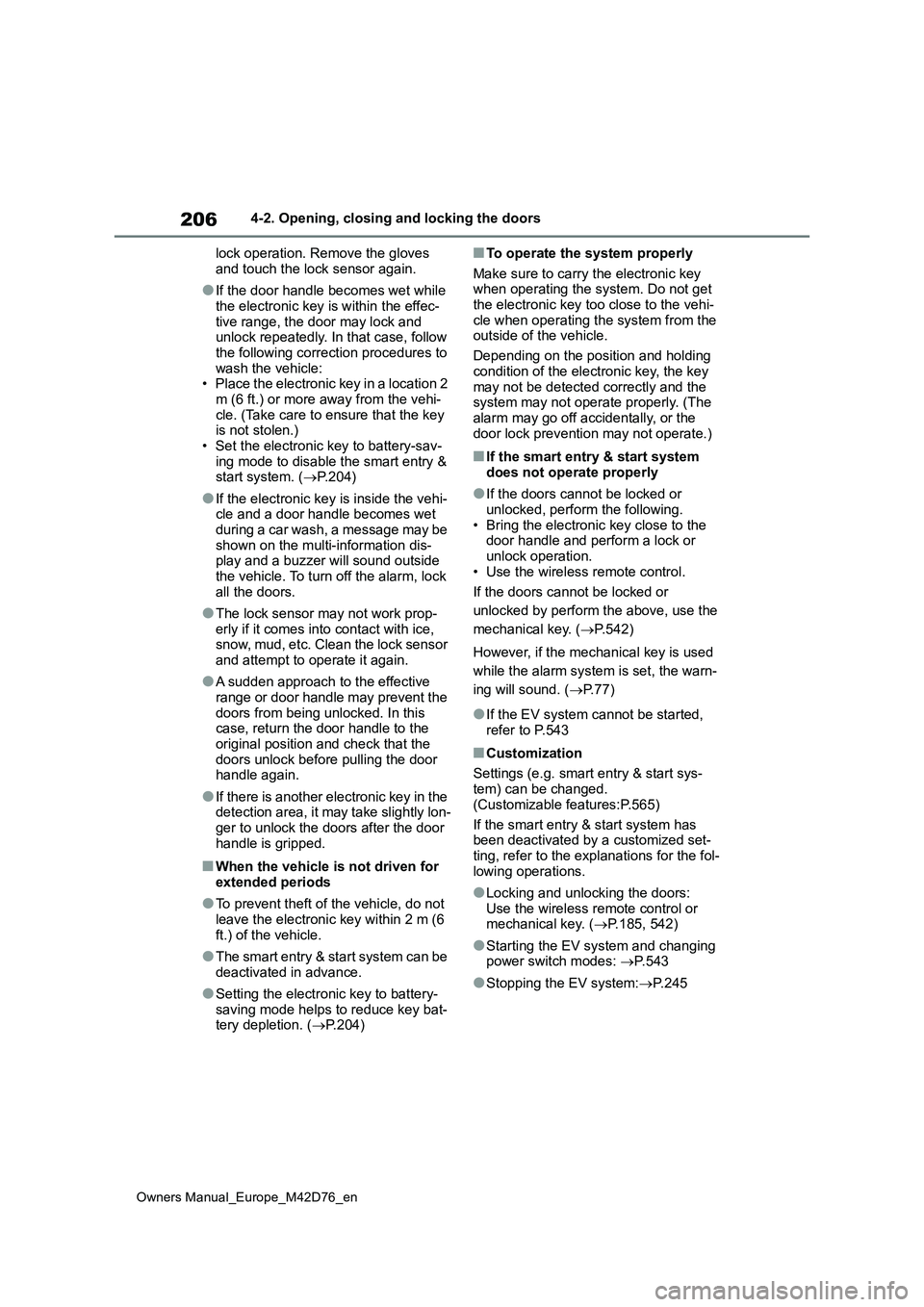
206
Owners Manual_Europe_M42D76_en
4-2. Opening, closing and locking the doors
lock operation. Remove the gloves
and touch the lock sensor again.
●If the door handle becomes wet while
the electronic key is within the effec- tive range, the door may lock and unlock repeatedly. In that case, follow
the following correction procedures to wash the vehicle:• P l ac e t h e e l ec t ro n ic ke y i n a l oc at i o n 2
m (6 ft.) or more away from the vehi- cle. (Take care to ensure that the key is not stolen.)
• Set the electronic key to battery-sav- ing mode to disable the smart entry & start system. ( P.204)
●If the electronic key is inside the vehi- cle and a door handle becomes wet
during a car wash, a message may be shown on the multi-information dis-play and a buzzer will sound outside
the vehicle. To turn off the alarm, lock all the doors.
●The lock sensor may not work prop-erly if it comes into contact with ice, snow, mud, etc. Clean the lock sensor
and attempt to operate it again.
●A sudden approach to the effective
range or door handle may prevent the doors from being unlocked. In this case, return the door handle to the
original position and check that the doors unlock before pulling the door handle again.
●If there is another electronic key in the detection area, it may take slightly lon-
ger to unlock the doors after the door handle is gripped.
■When the vehicle is not driven for extended periods
●To prevent theft of the vehicle, do not leave the electronic key within 2 m (6
ft.) of the vehicle.
●The smart entry & start system can be
deactivated in advance.
●Setting the electronic key to battery-
saving mode helps to reduce key bat- tery depletion. ( P.204)
■To operate the system properly
Make sure to carry the electronic key when operating the system. Do not get the electronic key too close to the vehi-
cle when operating the system from the outside of the vehicle.
Depending on the position and holding
condition of the electronic key, the key may not be detected correctly and the system may not operate properly. (The
alarm may go off accidentally, or the door lock prevention may not operate.)
■If the smart entry & start system does not operate properly
●If the doors cannot be locked or unlocked, perform the following.
• Bring the electronic key close to the door handle and perform a lock or unlock operation.
• Use the wireless remote control.
If the doors cannot be locked or
unlocked by perform the above, use the
mechanical key. ( P.542)
However, if the mechanical key is used
while the alarm system is set, the warn-
ing will sound. ( P.77)
●If the EV system cannot be started,
refer to P.543
■Customization
Settings (e.g. smart entry & start sys- tem) can be changed.
(Customizable features:P.565)
If the smart entry & start system has been deactivated by a customized set-
ting, refer to the explanations for the fol- lowing operations.
●Locking and unlocking the doors:Use the wireless remote control or mechanical key. ( P.185, 542)
●Starting the EV system and changing power switch modes: P. 5 4 3
●Stopping the EV system:P. 2 4 5
Page 231 of 674
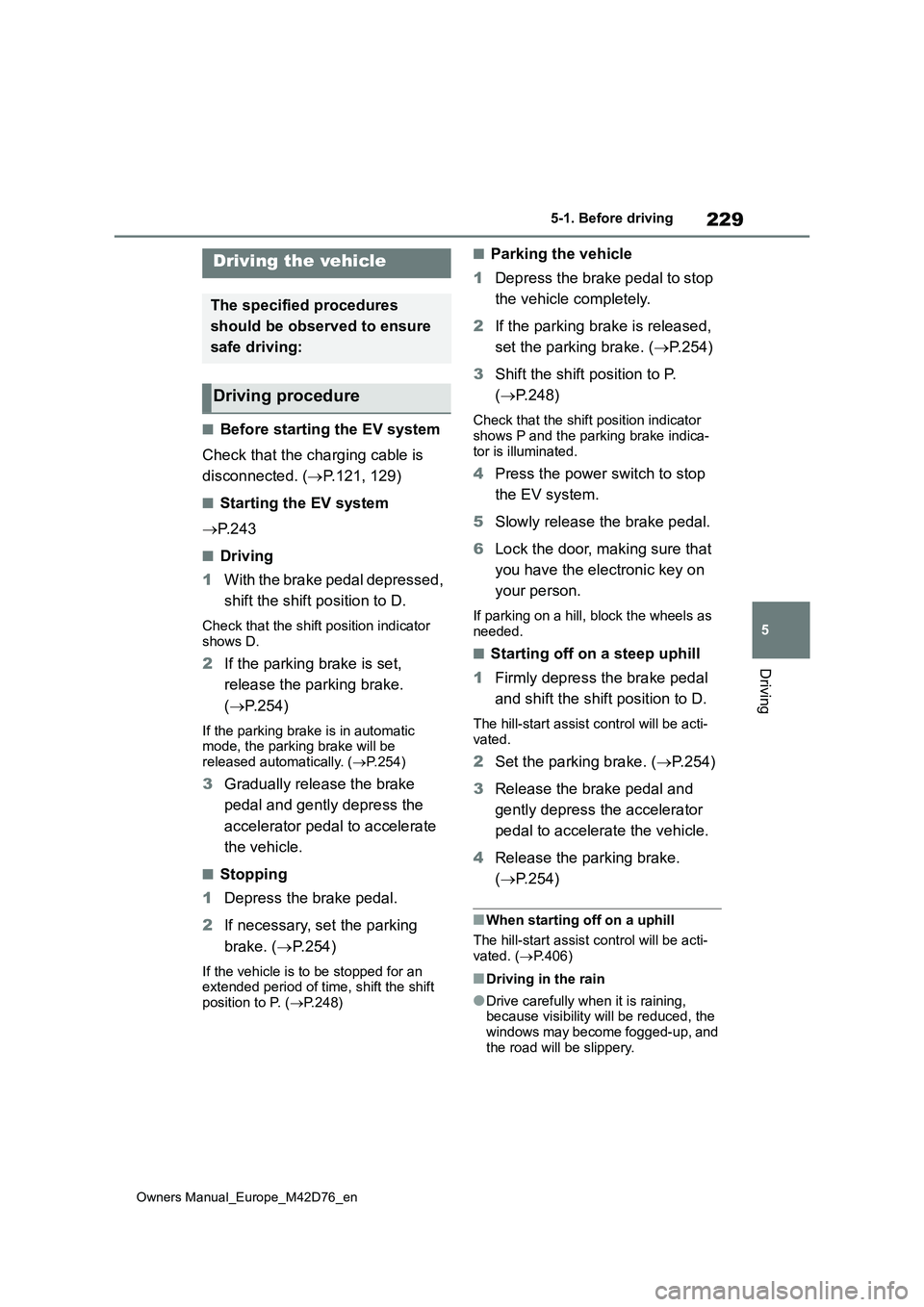
229
5
Owners Manual_Europe_M42D76_en
5-1. Before driving
Driving
5-1.Before driv in g
■Before starting the EV system
Check that the charging cable is
disconnected. ( P.121, 129)
■Starting the EV system
P. 2 4 3
■Driving
1 With the brake pedal depressed,
shift the shift position to D.
Check that the shift position indicator
shows D.
2 If the parking brake is set,
release the parking brake.
( P.254)
If the parking brake is in automatic mode, the parking brake will be released automatically. ( P.254)
3Gradually release the brake
pedal and gently depress the
accelerator pedal to accelerate
the vehicle.
■Stopping
1 Depress the brake pedal.
2 If necessary, set the parking
brake. ( P.254)
If the vehicle is to be stopped for an extended period of time, shift the shift position to P. ( P.248)
■Parking the vehicle
1 Depress the brake pedal to stop
the vehicle completely.
2 If the parking brake is released,
set the parking brake. ( P.254)
3 Shift the shift position to P.
( P.248)
Check that the shift position indicator shows P and the parking brake indica-
tor is illuminated.
4 Press the power switch to stop
the EV system.
5 Slowly release the brake pedal.
6 Lock the door, making sure that
you have the electronic key on
your person.
If parking on a hill, block the wheels as needed.
■Starting off on a steep uphill
1 Firmly depress the brake pedal
and shift the shift position to D.
The hill-start assist control will be acti-
vated.
2 Set the parking brake. (P.254)
3 Release the brake pedal and
gently depress the accelerator
pedal to accelerate the vehicle.
4 Release the parking brake.
( P.254)
■When starting off on a uphill
The hill-start assist control will be acti- vated. ( P.406)
■Driving in the rain
●Drive carefully when it is raining, because visibility will be reduced, the
windows may become fogged-up, and the road will be slippery.
Driving the vehicle
The specified procedures
should be observed to ensure
safe driving:
Driving procedure
Page 232 of 674

230
Owners Manual_Europe_M42D76_en
5-1. Before driving
●Drive carefully when it starts to rain,
because the road surface will be especially slippery.
●Refrain from high speeds when driv-ing on an expressway in the rain, because there may be a layer of water
between the tires and the road sur- face, preventing the steering and brakes from operating properly.
■Restraining the EV system output
(Brake Override System)
●When the accelerator and brake ped-
als are depressed at the same time, the EV system output may be restrained.
●A warning message is displayed on the multi-information display while the
system is operating.
■Breaking in your new Toyota
To extend the life of the vehicle, observ- ing the following precautions is recom-
mended:
●For the first 300 km (186 miles):
Avoid sudden stops.
●For the first 800 km (500 miles):
Do not tow a trailer.
●For the first 1000 km (621 miles):
• Do not drive at extremely high speeds.• Avoid sudden acceleration.
• Do not drive at a constant speed for extended periods.
WARNING
Observe the following precautions.
Failure to do so may result in death or serious injury.
■When starting the vehicle
Always keep your foot on the brake pedal while stopped with the
“READY” indicator is illuminated. This prevents the vehicle from creeping.
■When driving the vehicle
●Do not drive if you are unfamiliar with the location of the brake and
accelerator pedals to avoid depressing the wrong pedal.
• Accidentally depressing the accel- erator pedal instead of the brake pedal will result in sudden accelera-
tion that may lead to an accident.
• When backing up, you may twist
your body around, leading to diffi- culty in operating the pedals. Make sure to operate the pedals properly.
• Make sure to keep a correct driving posture even when moving the
vehicle only slightly. This allows you to depress the brake and accelera-tor pedals properly.
• Depress the brake pedal using your right foot. Depressing the brake
pedal using your left foot may delay response in an emergency, result-ing in an accident.
●The driver should pay extra atten-tion to pedestrians. As there is no
engine noise, the pedestrians may misjudge the vehicle’s movement. Even though the vehicle is
equipped with the Acoustic Vehicle Alerting System, drive with care as pedestrians in the vicinity may still
not notice the vehicle if the sur- rounding area is noisy.
●During normal driving, do not turn off the EV system. Turning the EV system off while driving will not
cause loss of steering or braking control, however, power assist to the steering will be lost. This will
make it more difficult to steer smoothly, so you should pull over and stop the vehicle as soon as it is
safe to do so. In the event of an emergency, such as if it becomes impossible to stop the vehicle in the
normal way: P. 5 0 6
Page 235 of 674
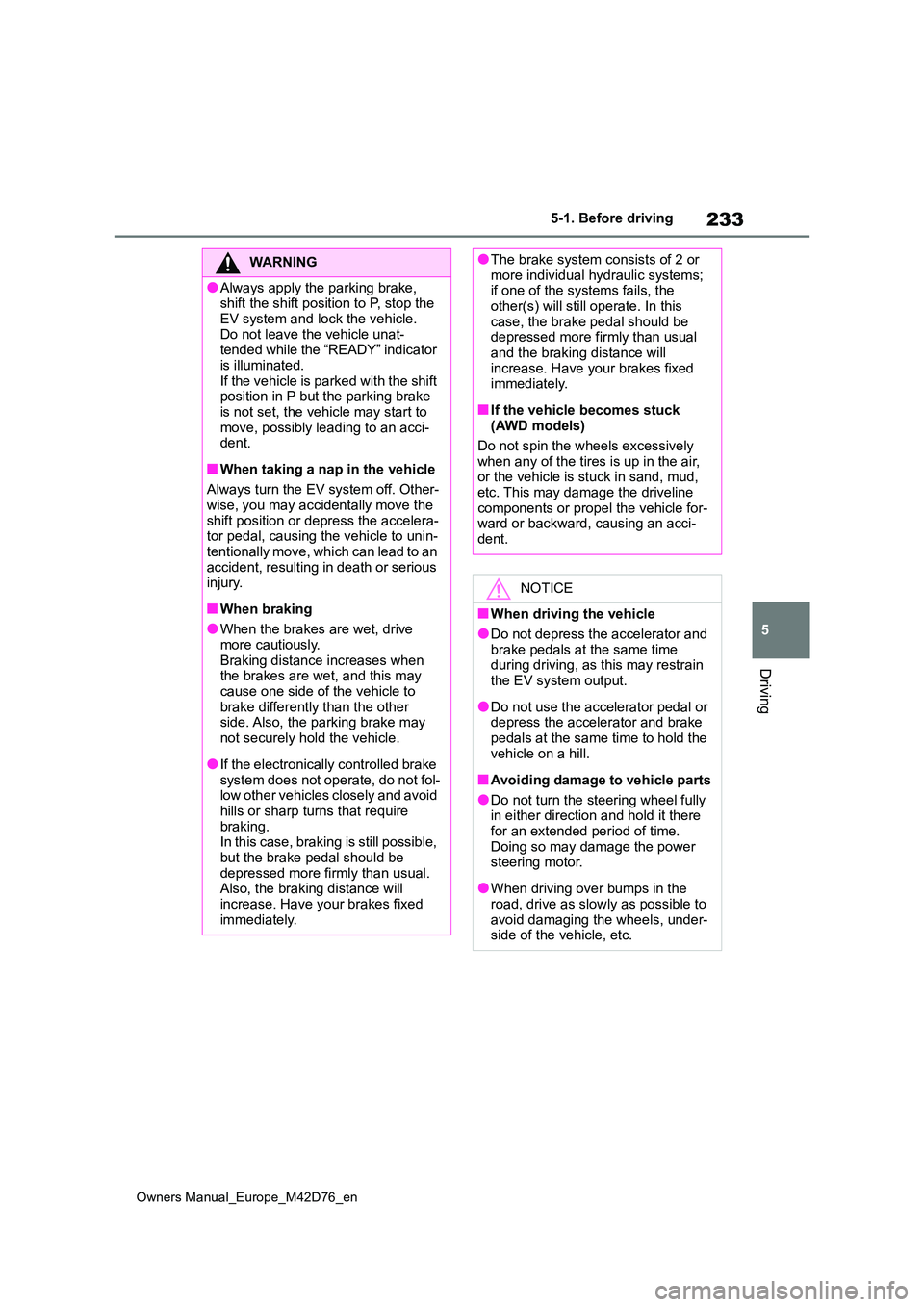
233
5
Owners Manual_Europe_M42D76_en
5-1. Before driving
Driving
WARNING
●Always apply the parking brake, shift the shift position to P, stop the
EV system and lock the vehicle. Do not leave the vehicle unat-tended while the “READY” indicator
is illuminated. If the vehicle is parked with the shift position in P but the parking brake
is not set, the vehicle may start to move, possibly leading to an acci-dent.
■When taking a nap in the vehicle
Always turn the EV system off. Other-
wise, you may accidentally move the shift position or depress the accelera-tor pedal, causing the vehicle to unin-
tentionally move, which can lead to an accident, resulting in death or serious injury.
■When braking
●When the brakes are wet, drive
more cautiously. Braking distance increases when the brakes are wet, and this may
cause one side of the vehicle to brake differently than the other side. Also, the parking brake may
not securely hold the vehicle.
●If the electronically controlled brake
system does not operate, do not fol- low other vehicles closely and avoid hills or sharp turns that require
braking. In this case, braking is still possible, but the brake pedal should be
depressed more firmly than usual. Also, the braking distance will increase. Have your brakes fixed
immediately.
●The brake system consists of 2 or more individual hydraulic systems; if one of the systems fails, the
other(s) will still operate. In this case, the brake pedal should be depressed more firmly than usual
and the braking distance will increase. Have your brakes fixed immediately.
■If the vehicle becomes stuck (AWD models)
Do not spin the wheels excessively when any of the tires is up in the air, or the vehicle is stuck in sand, mud,
etc. This may damage the driveline components or propel the vehicle for-ward or backward, causing an acci-
dent.
NOTICE
■When driving the vehicle
●Do not depress the accelerator and
brake pedals at the same time during driving, as this may restrain the EV system output.
●Do not use the accelerator pedal or depress the accelerator and brake
pedals at the same time to hold the vehicle on a hill.
■Avoiding damage to vehicle parts
●Do not turn the steering wheel fully in either direction and hold it there
for an extended period of time. Doing so may damage the power steering motor.
●When driving over bumps in the road, drive as slowly as possible to
avoid damaging the wheels, under- side of the vehicle, etc.
Page 238 of 674
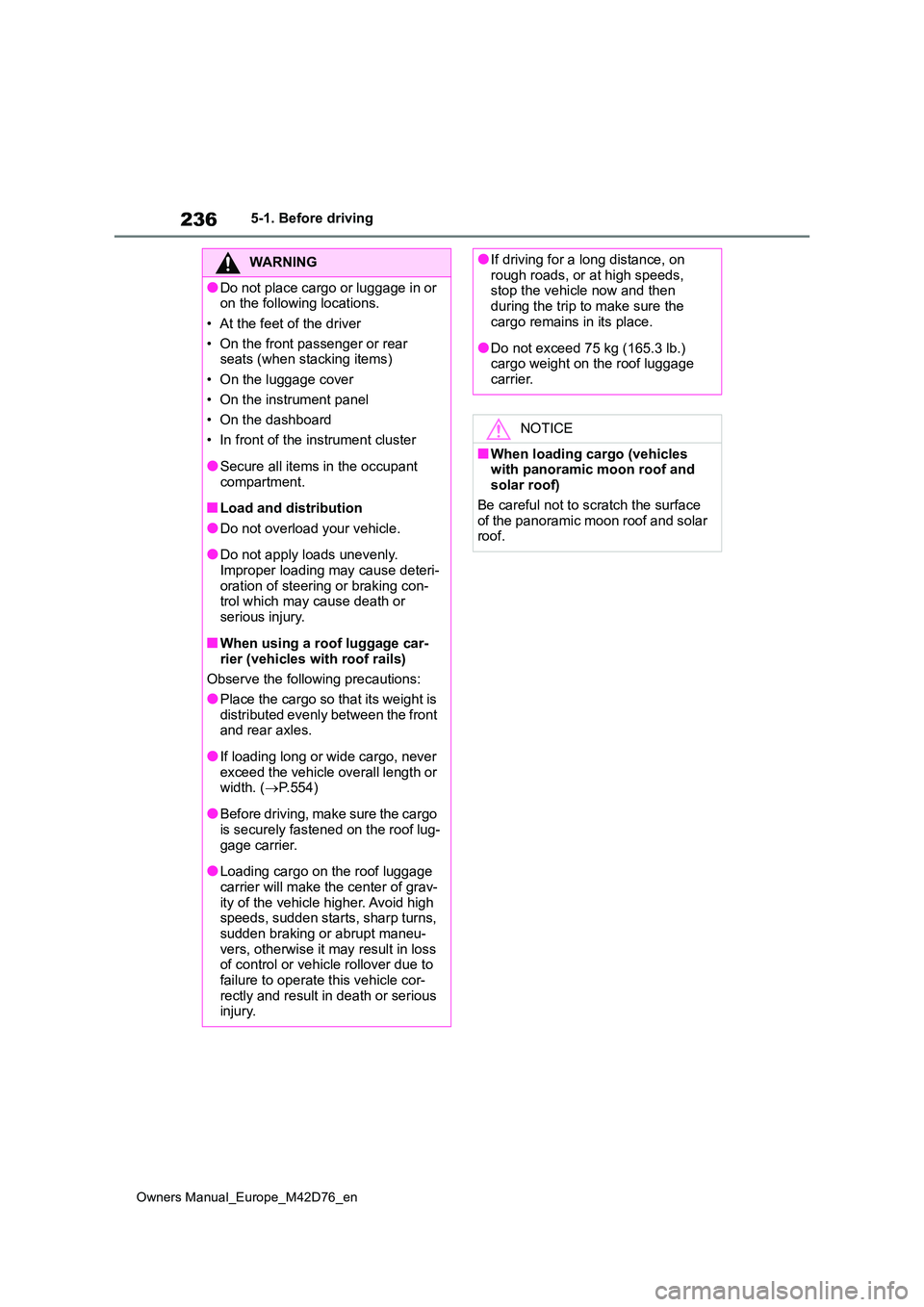
236
Owners Manual_Europe_M42D76_en
5-1. Before driving
WARNING
●Do not place cargo or luggage in or on the following locations.
• At the feet of the driver
• On the front passenger or rear seats (when stacking items)
• On the luggage cover
• On the instrument panel
• On the dashboard
• In front of the instrument cluster
●Secure all items in the occupant
compartment.
■Load and distribution
●Do not overload your vehicle.
●Do not apply loads unevenly.
Improper loading may cause deteri- oration of steering or braking con-trol which may cause death or
serious injury.
■When using a roof luggage car-
rier (vehicles with roof rails)
Observe the following precautions:
●Place the cargo so that its weight is
distributed evenly between the front and rear axles.
●If loading long or wide cargo, never exceed the vehicle overall length or width. ( P.554)
●Before driving, make sure the cargo is securely fastened on the roof lug-
gage carrier.
●Loading cargo on the roof luggage
carrier will make the center of grav- ity of the vehicle higher. Avoid high speeds, sudden starts, sharp turns,
sudden braking or abrupt maneu- vers, otherwise it may result in loss of control or vehicle rollover due to
failure to operate this vehicle cor- rectly and result in death or serious injury.
●If driving for a long distance, on rough roads, or at high speeds, stop the vehicle now and then
during the trip to make sure the cargo remains in its place.
●Do not exceed 75 kg (165.3 lb.) cargo weight on the roof luggage carrier.
NOTICE
■When loading cargo (vehicles with panoramic moon roof and solar roof)
Be careful not to scratch the surface of the panoramic moon roof and solar roof.
Page 242 of 674
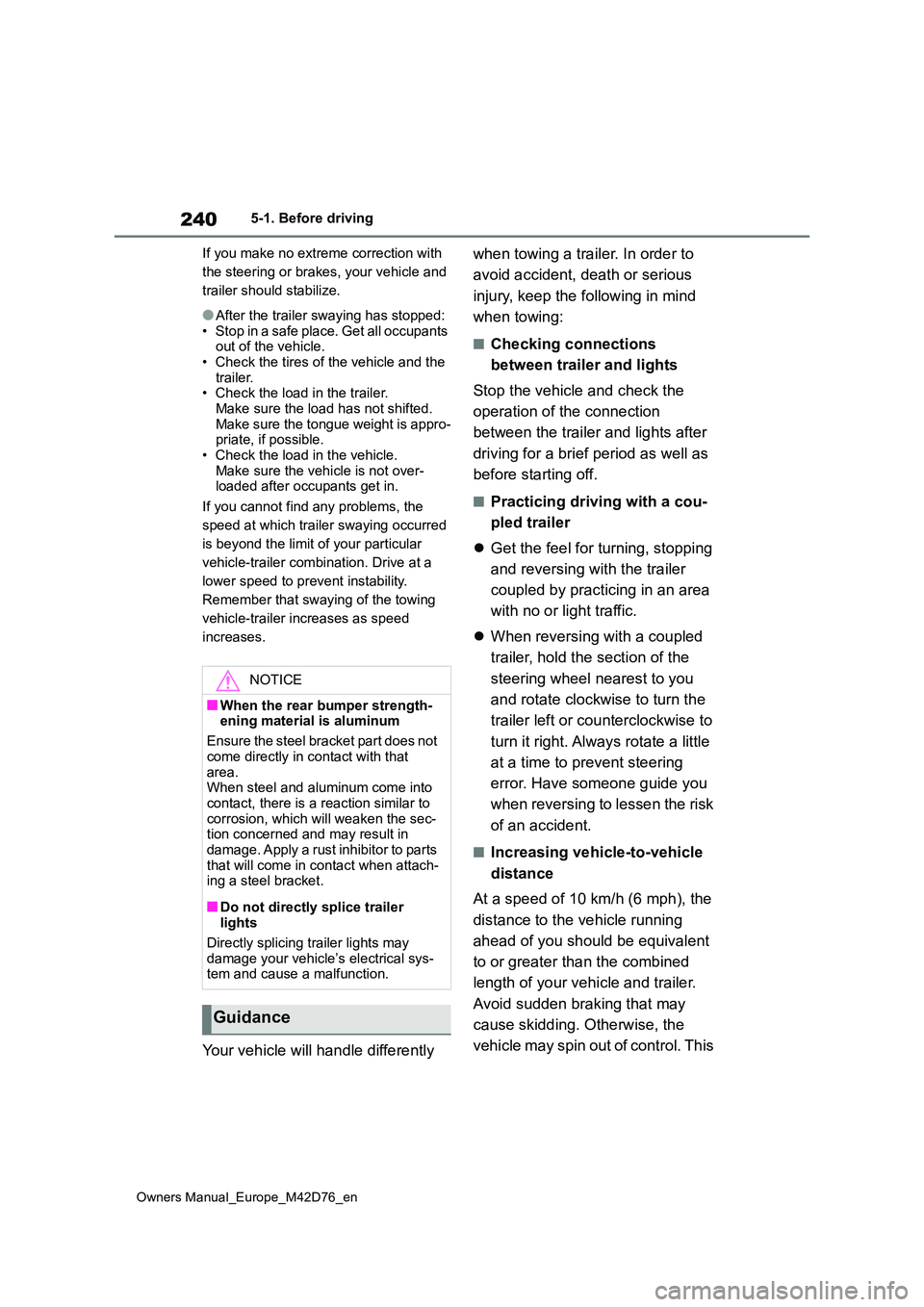
240
Owners Manual_Europe_M42D76_en
5-1. Before driving
If you make no extreme correction with
the steering or brakes, your vehicle and
trailer should stabilize.
●After the trailer swaying has stopped: • Stop in a safe place. Get all occupants out of the vehicle.
• Check the tires of the vehicle and the trailer.• Check the load in the trailer.
Make sure the load has not shifted. Make sure the tongue weight is appro-priate, if possible.
• Check the load in the vehicle. Make sure the vehicle is not over-loaded after occupants get in.
If you cannot find any problems, the
speed at which trailer swaying occurred
is beyond the limit of your particular
vehicle-trailer combination. Drive at a
lower speed to prevent instability.
Remember that swaying of the towing
vehicle-trailer increases as speed
increases.
Your vehicle will handle differently
when towing a trailer. In order to
avoid accident, death or serious
injury, keep the following in mind
when towing:
■Checking connections
between trailer and lights
Stop the vehicle and check the
operation of the connection
between the trailer and lights after
driving for a brief period as well as
before starting off.
■Practicing driving with a cou-
pled trailer
Get the feel for turning, stopping
and reversing with the trailer
coupled by practicing in an area
with no or light traffic.
When reversing with a coupled
trailer, hold the section of the
steering wheel nearest to you
and rotate clockwise to turn the
trailer left or counterclockwise to
turn it right. Always rotate a little
at a time to prevent steering
error. Have someone guide you
when reversing to lessen the risk
of an accident.
■Increasing vehicle-to-vehicle
distance
At a speed of 10 km/h (6 mph), the
distance to the vehicle running
ahead of you should be equivalent
to or greater than the combined
length of your vehicle and trailer.
Avoid sudden braking that may
cause skidding. Otherwise, the
vehicle may spin out of control. This
NOTICE
■When the rear bumper strength- ening material is aluminum
Ensure the steel bracket part does not
come directly in contact with that area.When steel and aluminum come into
contact, there is a reaction similar to corrosion, which will weaken the sec-tion concerned and may result in
damage. Apply a rust inhibitor to parts that will come in contact when attach-ing a steel bracket.
■Do not directly splice trailer lights
Directly splicing trailer lights may damage your vehicle’s electrical sys-tem and cause a malfunction.
Guidance
Page 243 of 674
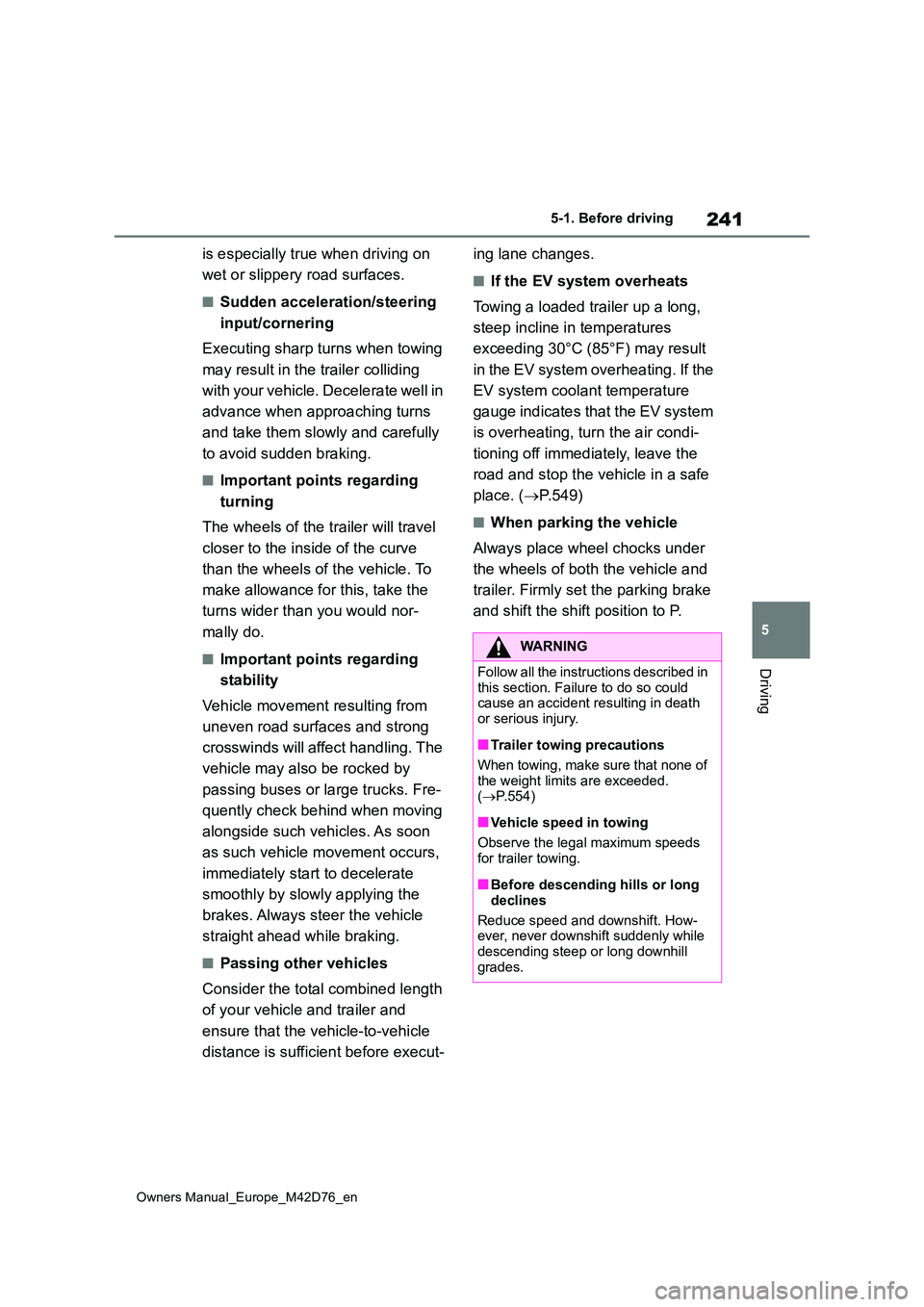
241
5
Owners Manual_Europe_M42D76_en
5-1. Before driving
Driving
is especially true when driving on
wet or slippery road surfaces.
■Sudden acceleration/steering
input/cornering
Executing sharp turns when towing
may result in the trailer colliding
with your vehicle. Decelerate well in
advance when approaching turns
and take them slowly and carefully
to avoid sudden braking.
■Important points regarding
turning
The wheels of the trailer will travel
closer to the inside of the curve
than the wheels of the vehicle. To
make allowance for this, take the
turns wider than you would nor-
mally do.
■Important points regarding
stability
Vehicle movement resulting from
uneven road surfaces and strong
crosswinds will affect handling. The
vehicle may also be rocked by
passing buses or large trucks. Fre-
quently check behind when moving
alongside such vehicles. As soon
as such vehicle movement occurs,
immediately start to decelerate
smoothly by slowly applying the
brakes. Always steer the vehicle
straight ahead while braking.
■Passing other vehicles
Consider the total combined length
of your vehicle and trailer and
ensure that the vehicle-to-vehicle
distance is sufficient before execut-
ing lane changes.
■If the EV system overheats
Towing a loaded trailer up a long,
steep incline in temperatures
exceeding 30°C (85°F) may result
in the EV system overheating. If the
EV system coolant temperature
gauge indicates that the EV system
is overheating, turn the air condi-
tioning off immediately, leave the
road and stop the vehicle in a safe
place. ( P.549)
■When parking the vehicle
Always place wheel chocks under
the wheels of both the vehicle and
trailer. Firmly set the parking brake
and shift the shift position to P.
WARNING
F o l l o w a l l t h e i n s t r u c t i o n s d e s c r i b e d i n this section. Failure to do so could cause an accident resulting in death
or serious injury.
■Trailer towing precautions
When towing, make sure that none of the weight limits are exceeded. ( P.554)
■Vehicle speed in towing
Observe the legal maximum speeds
for trailer towing.
■Before descending hills or long
declines
Reduce speed and downshift. How- ever, never downshift suddenly while
descending steep or long downhill grades.
Page 247 of 674
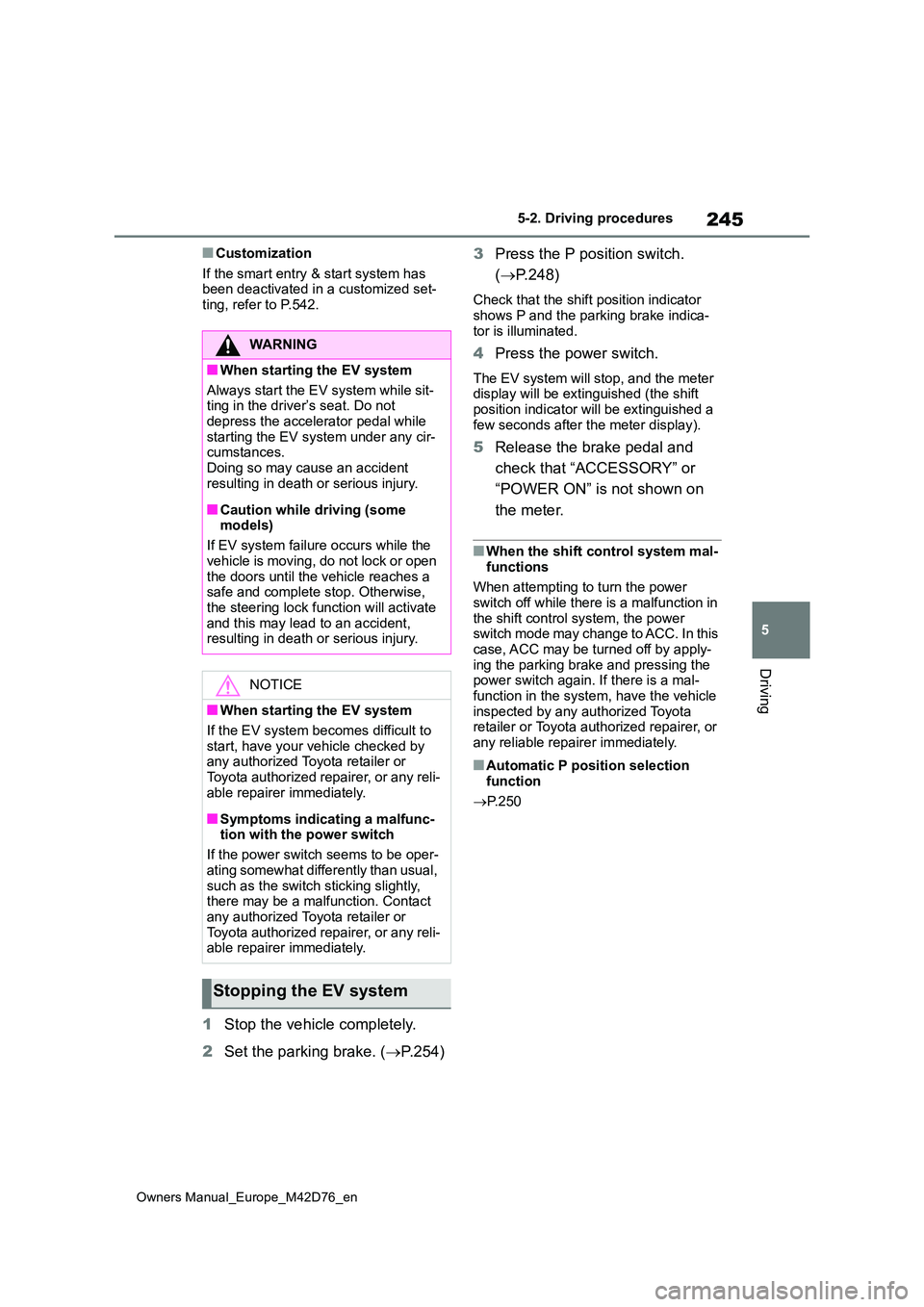
245
5
Owners Manual_Europe_M42D76_en
5-2. Driving procedures
Driving
■Customization
If the smart entry & start system has been deactivated in a customized set-ting, refer to P.542.
1 Stop the vehicle completely.
2 Set the parking brake. (P.254)
3 Press the P position switch.
( P.248)
Check that the shift position indicator
shows P and the parking brake indica- tor is illuminated.
4 Press the power switch.
The EV system will stop, and the meter display will be extinguished (the shift
position indicator will be extinguished a few seconds after the meter display).
5 Release the brake pedal and
check that “ACCESSORY” or
“POWER ON” is not shown on
the meter.
■When the shift control system mal-
functions
When attempting to turn the power switch off while there is a malfunction in
the shift control system, the power switch mode may change to ACC. In this case, ACC may be turned off by apply-
ing the parking brake and pressing the power switch again. If there is a mal-function in the system, have the vehicle
inspected by any authorized Toyota retailer or Toyota authorized repairer, or any reliable repairer immediately.
■Automatic P position selection
function
P. 2 5 0
WARNING
■When starting the EV system
Always start the EV system while sit- ting in the driver’s seat. Do not
depress the accelerator pedal while starting the EV system under any cir-cumstances.
Doing so may cause an accident resulting in death or serious injury.
■Caution while driving (some models)
If EV system failure occurs while the
vehicle is moving, do not lock or open the doors until the vehicle reaches a safe and complete stop. Otherwise,
the steering lock function will activate and this may lead to an accident, resulting in death or serious injury.
NOTICE
■When starting the EV system
If the EV system becomes difficult to start, have your vehicle checked by any authorized Toyota retailer or
Toyota authorized repairer, or any reli- able repairer immediately.
■Symptoms indicating a malfunc-tion with the power switch
If the power switch seems to be oper-
ating somewhat differently than usual, such as the switch sticking slightly, there may be a malfunction. Contact
any authorized Toyota retailer or Toyota authorized repairer, or any reli-able repairer immediately.
Stopping the EV system
Page 248 of 674
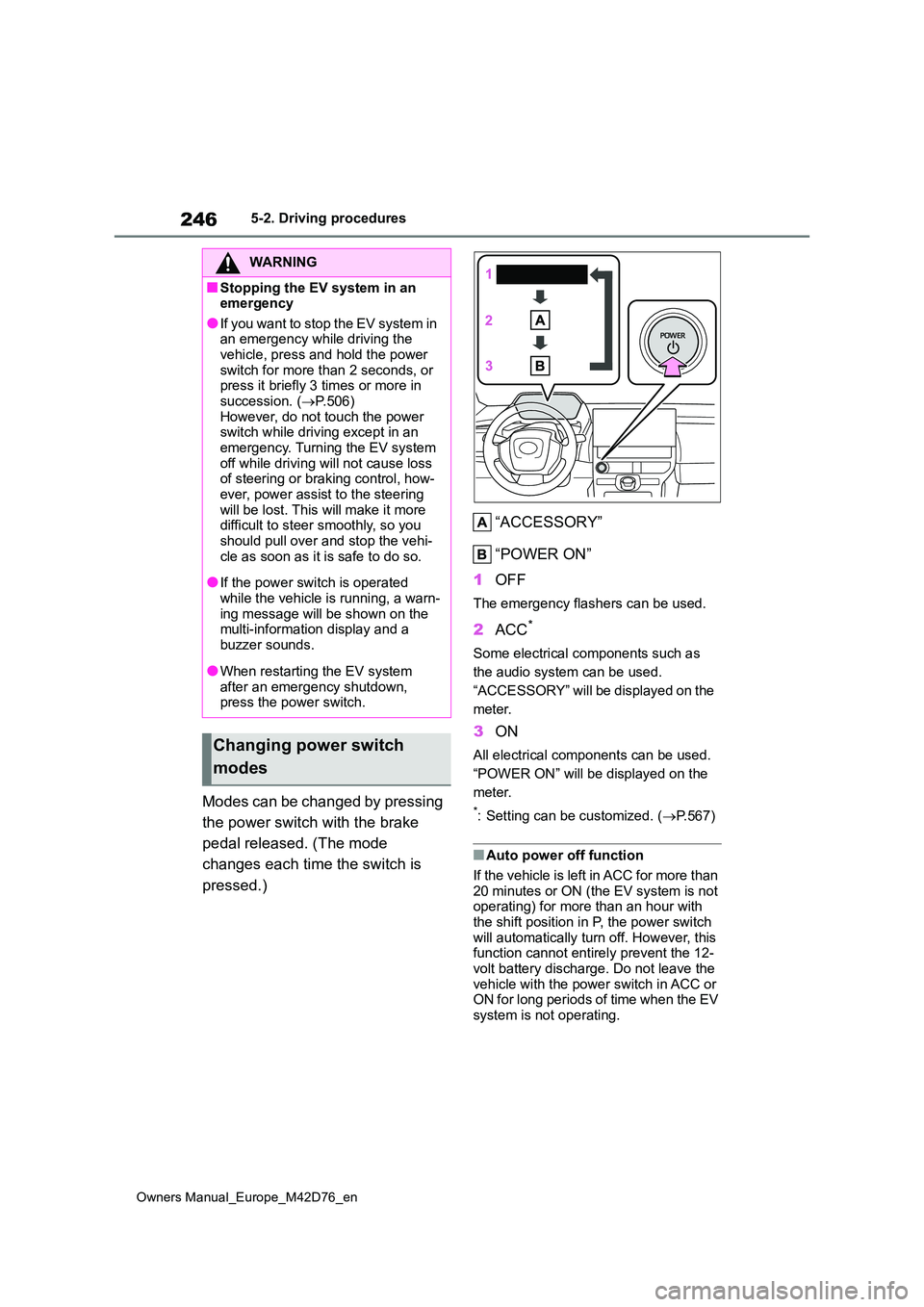
246
Owners Manual_Europe_M42D76_en
5-2. Driving procedures
Modes can be changed by pressing
the power switch with the brake
pedal released. (The mode
changes each time the switch is
pressed.)
“ACCESSORY”
“POWER ON”
1 OFF
The emergency flashers can be used.
2ACC*
Some electrical components such as
the audio system can be used.
“ACCESSORY” will be displayed on the
meter.
3 ON
All electrical components can be used.
“POWER ON” will be displayed on the
meter.
*: Setting can be customized. ( P.567)
■Auto power off function
If the vehicle is left in ACC for more than
20 minutes or ON (the EV system is not operating) for more than an hour with the shift position in P, the power switch
will automatically turn off. However, this function cannot entirely prevent the 12-volt battery discharge. Do not leave the
vehicle with the power switch in ACC or ON for long periods of time when the EV system is not operating.
WARNING
■Stopping the EV system in an emergency
●If you want to stop the EV system in an emergency while driving the vehicle, press and hold the power
switch for more than 2 seconds, or press it briefly 3 times or more in succession. ( P.506)
However, do not touch the power switch while driving except in an emergency. Turning the EV system
off while driving will not cause loss of steering or braking control, how-ever, power assist to the steering
will be lost. This will make it more difficult to steer smoothly, so you should pull over and stop the vehi-
cle as soon as it is safe to do so.
●If the power switch is operated
while the vehicle is running, a warn- ing message will be shown on the multi-information display and a
buzzer sounds.
●When restarting the EV system
after an emergency shutdown, press the power switch.
Changing power switch
modes
Page 252 of 674

250
Owners Manual_Europe_M42D76_en
5-2. Driving procedures
■When N is selected while driving
When selecting N while traveling at a speed above a certain level, hold the rotary shifter at the N position.
■Automatic P position selection
function
In the following situations, the shift posi- tion is automatically changed to P.
●When pressing the power switch with
the vehicle stopped while the power
swi t ch i s i n ON a n d t h e s h if t po si t i on is in a position other than P (after the shift position has been changed to P,
the power switch will turn off)*
●If the driver’s door is opened and all of
the following conditions are met, while the shift position is in a position other than P:
• The power switch is in ON. • The driver is not wearing the seat belt.• The brake pedal is not depressed.
To start off the vehicle after the shift
position is changed to P, operate the
rotary shifter again.
●When the vehicle is stopped after the EV system has been stopped in an
emergency while driving
●When voltage of the 12-volt battery
drops while the shift position is in a position other than P*: When the power switch is pressed
while driving at extremely slow
speeds, such as immediately before
stopping the vehicle, the shift position
may automatically change to P. Make
sure that the vehicle is completely
stopped before pressing the power
switch.
■If the shift position cannot be
shifted from P
There is a possibility that the 12-volt bat- tery is discharged. Check the 12-volt
battery in this situation. ( P.544)
■Customization
Some functions can be customized.
( P.567)
WARNING
■For the rotary shifter
●Do not remove the rotary shifter knob or use anything but a genuine
Toyota rotary shifter knob. Also, do not hang anything on the rotary shifter.
Doing so could prevent the rotary shifter from returning to position, causing unexpected accidents to
occur when the vehicle is in motion.
●In order to prevent the shift position
from accidentally being changed, do not touch the rotary shifter when not using it.
■P position switch
●Do not press the P position switch
while the vehicle is moving. If the P position switch is pressed when driving at very low speeds (for
example, directly before stopping the vehicle), the vehicle may stop suddenly when the shift position
switches to P, which could lead to an accident.
●In order to prevent the shift position from accidentally being changed, do not touch the P position switch
when not using it.
NOTICE
■When exiting the vehicle (driver’s seat only)
Check that the shift position indicator
shows P and that the parking brake indicator is illuminated before opening the door and exiting the vehicle.